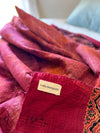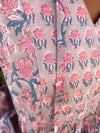
Block printing is an artisanal method of dyeing fabrics using wooden blocks. Today, Rajasthan's block printing is well known, having withstood the test of time, social upheaval, and the advent of the mass textile industry. Artisans continue to print by hand, using techniques that have remained virtually unchanged for centuries. What was once a traditional necessity has become a rare and precious luxury, an alternative to standardized and impersonalized textiles.
Blockprinting is a meticulous craft, where every detail is carefully considered and executed. Artisans, called chippas, hand-carve wooden blocks, engraving intricate designs into sturdy materials such as teak or mango wood. These motifs, often inspired by nature—flowers, leaves, trees, and animals—or by geometric symbols, are both simple and incredibly rich. Each engraved wooden block is a masterpiece in itself, a product of the artisan's patience and skill.
During printing, these blocks, dipped in dye, are applied to the fabric with a precision and regularity that defies the eye. Each stroke of the block is an act of creation, where the artisan's gesture merges with the fabric to give life to vibrant patterns. This manual process, marked by slowness and meticulousness, transforms each piece of fabric into a unique work of art. No machine can reproduce the magic and finesse of these artisanal prints, where the subtle imperfection of the handmade becomes a mark of authenticity and beauty.
One of the strengths of Rajasthani blockprinting lies in its use of natural dyes derived from the earth and plants. The deep blues of indigo, the intense reds of madder, the sunny yellows of turmeric, and the delicate greens obtained from the combination of leaves and minerals give the fabrics colors of a natural, organic intensity.
Blockprint motifs carry symbols and meanings. They tell ancient stories, evoke legends, and reflect daily life in Rajasthani villages. Floral motifs recall the lush gardens of royal courts, geometric shapes embody the harmony of the universe, while animal representations—elephants, peacocks, and horses—symbolize strength, beauty, and nobility.
Sanganeri motifs, for example, originating from the town of Sanganer, are famous for their delicate florals and airy compositions. The more earthy and geometric Bagru motifs, from the village of Bagru, celebrate simplicity and balance of form. Each region of Rajasthan has developed its own style, a visual identity expressed through hundreds of unique motifs, each imbued with meaning and history.
In the face of the homogeneity of mass-produced products, blockprinting stands as a silent resistance. It celebrates diversity, human imperfection, and the beauty of handcraftsmanship. Each piece is unique, marked by the artisan's hand, and carries within it the subtle imperfections that make handmade unique.




0 comments